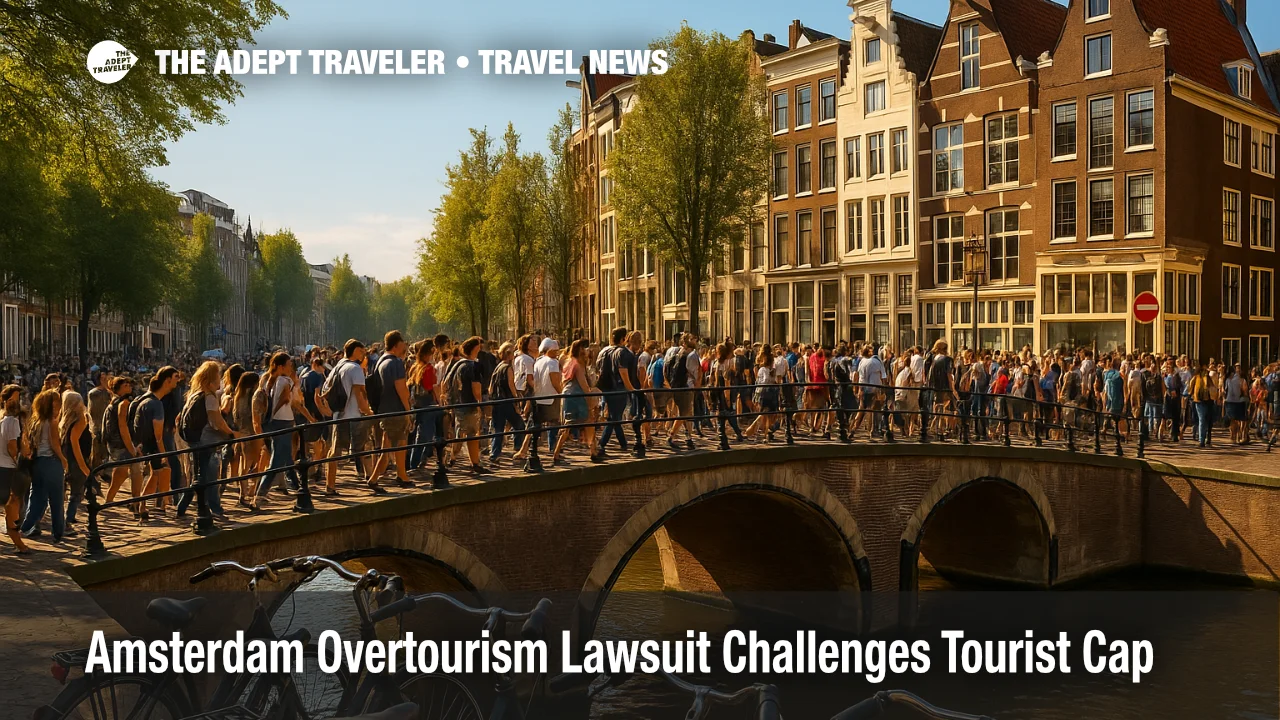Amsterdam overtourism lawsuit challenges tourist cap

Amsterdam residents have filed suit against the municipality, arguing the city failed to enforce its self-imposed 20 million cap on annual tourist overnight stays. City data show 22.9 million stays in 2024, a 3 percent year-over-year rise, with 2025 projected to be higher. Activists say current policies have slowed growth but not reduced crowding, and they want stronger tools, including another increase to Europe's highest tourist tax. The case tests whether Amsterdam's 2021 "tourism in balance" policy has legal teeth, and how far a city can go to manage visitor pressure without undercutting a key economic engine.
Key Points
- Why it matters: A court ruling could force tougher limits on hotels, short-term rentals, and cruises.
- Travel impact: Higher costs, fewer ship calls, and tighter rental rules may shift demand to other Dutch cities.
- What's next: Hearings will examine whether Amsterdam complied with its cap and acted when thresholds were crossed.
- Residents want a new hike to the tourist tax beyond the current 12.5 percent.
- City measures already include a new-hotel ban and reduced cruise calls.
Snapshot
A citizens' initiative, Amsterdam Has a Choice, raised about €50,000 to bring the case and says the city has exceeded its overnight-stays ceiling for three straight years. Officials counter that a suite of policies is starting to bite, citing slower growth since 2023, higher lodging taxes, fewer river and sea cruise calls, and a freeze on new hotels unless beds do not increase. Still, 22.9 million stays in 2024, up 3 percent, left the cap unmet. Projections for 2025 range from roughly 23 million to 24.6 million nights. The lawsuit seeks stronger enforcement of existing rules and fresh steps to cut nuisance tourism, while residents call for reinvesting any new tax revenue in housing and street cleaning.
Background
In June 2021, Amsterdam adopted a policy tying action to visitor thresholds, requiring interventions once annual overnight stays hit 18 million and setting a 20 million ceiling. Since then the city has tightened short-term rental rules, advanced "stay away" messaging to misbehavior-focused visitors, and raised the hotel tax to 12.5 percent, the highest among major European cities. In April 2024, the city also moved to halt new hotel construction, allowing only replacement projects that do not add beds and improve sustainability. River and sea cruise volumes have been curtailed as part of a wider effort to reduce congestion in the historic center. Residents argue these measures remain insufficient to restore quality of life in the most crowded neighborhoods.
Latest Developments
Residents file suit after cap exceeded again
On September 22, 2025, residents backed by 12 neighborhood groups filed their complaint, saying the city failed to act decisively despite surpassing the cap in 2022, 2023, and 2024. Organizers cite a 3 percent rise to 22.9 million overnight stays in 2024 and forecasts that 2025 will again exceed the limit. They want stricter enforcement against illegal rentals, more aggressive limits on hotel capacity growth, and a firmer hand on cruise calls. City officials say growth has slowed due to past measures, but acknowledge the cap has not yet been met.
Europe's highest tourist tax under fresh scrutiny
Amsterdam's hotel tax is 12.5 percent of the nightly rate, and the day-trip cruise levy is €14.50 per passenger. Plaintiffs argue another increase could both curb demand and fund local priorities, including purchasing housing and expanding cleaning services near nightlife corridors. A parallel political push would raise the levy further to finance free public transport for residents, underscoring how central the tax has become to the overtourism debate.
Hotel freeze and cruise cuts frame supply-side approach
The city's hotel policy allows new builds only if another hotel closes and bed counts do not rise, prioritizing sustainability upgrades instead. Officials also report fewer river cruise movements and a sharp reduction in annual sea-cruise calls. Combined with rental restrictions, the measures aim to spread visitors beyond the center and limit capacity creep, while preserving tourism's economic value.
Analysis
Amsterdam's test case blends law, economics, and urban livability. The legal question is whether the 2021 framework created enforceable duties, not just policy aspirations. If a court finds the city failed to act after crossing the 18 million threshold, it could mandate stronger corrective steps, potentially including stricter rental caps, tougher hotel permit controls, and tighter cruise berths. Economically, the city balances a robust visitor economy with resident well-being. A higher tourist tax may trim budget options for price-sensitive travelers, shift stays to suburban or secondary Dutch markets, and modestly reduce peak demand, yet it could also fund cleaning, transit, and housing interventions that make tourism more sustainable. For travelers, the near-term effect is more price transparency, possible reductions in cruise offerings, and a continued nudge toward respectful behavior. For other European cities wrestling with mass tourism, the outcome could shape a playbook that pairs fiscal tools with supply controls and behavioral enforcement.
Final Thoughts
For now, travelers should expect higher lodging costs, stricter rental compliance, and fewer cruise options while the court weighs the Amsterdam overtourism lawsuit. Book early, compare hotel and rental prices across Greater Amsterdam, and watch for neighborhood-level rules that might affect stays. However the case lands, the city's policy mix will keep evolving, and the cap on overnight stays will remain the benchmark for success.
Sources
- Amsterdam residents sue city over mass tourism, NL Times
- Policy: Tourism, City of Amsterdam
- Tourist tax, City of Amsterdam
- Amsterdam tourist nights hit 23 million, surpassing city limit, DutchNews.nl
- Amsterdam's tourism growth slowing due to measures, NL Times
- Amsterdam bans new hotels in fight against mass tourism, Reuters
- Why Amsterdam's residents are suing over mass tourism, Euronews
